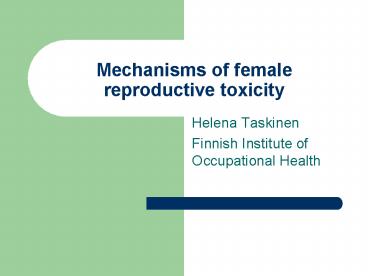Mechanisms of female reproductive toxicity - PowerPoint PPT Presentation
1 / 22
Title:
Mechanisms of female reproductive toxicity
Description:
Hypothalamus: hypothalamic-releasing factor, gonadotropin-releasing hormone ... in rats: follicular atresia, changes in uterine microcirculation; decreased ... – PowerPoint PPT presentation
Number of Views:1136
Avg rating:3.0/5.0
Title: Mechanisms of female reproductive toxicity
1
Mechanisms of female reproductive toxicity
- Helena Taskinen
- Finnish Institute of Occupational Health
2
Critical points of female fertility
- libido, sexual behaviour
- oogenesis
- hormonal function
- fertilization
- transportation
- implantation
3
Developmental toxicity
- gameto-, embryo- and fetotoxicity
- abortion, stillbirth
- teratogenic effetcs
- intrauterine growth retardation
- functional defects
- impaired mental and physical postnatal
development up to puberty - childhood cancer
4
Hypothalamo-pituitary-ovarian axis
- Hypothalamus hypothalamic-releasing factor,
gonadotropin-releasing hormone - Pituitary Gonadotropin-releasing hormone,
gonadotropins follicle stimulating hormone (FSH)
and luteinizing hormone (LH) - Ovary estrogen and progesterone
- Agents that disturb the axis can disrupt ovarian
function
5
Hypothalamo- Pituitary- Ovarian axis
Hypothalamus
Hypothalamic factors
Progesteron, estrogen
Pituitary gland
Gonadotropins, prolactin
Ovary
6
Mechanisms of toxins 1
- Direct acting toxins structurally similar or
chemically reactive - Direct damage to cells, organelles, DNA/RNA,
enzymatic and biochemical pathways - alkylating compunds, metals (boron, cadmium,
lead, mercury) and ionizing radiation
7
- Indirect toxins metabolic activation produces
reactive intermediates - cyclophosphamide, DDT, PAH, dibromochloropropane
8
Mechanisms of toxins 2
- Hormone agonists or antagonists
- oral contraceptives, DDT, methoxychlor,
polychlorinated biphenyls, polybrominated
biphenyls, organochlorine pesticides - Cellular (oocyte) death necrosis
- pesticides, PAH in cigarette smoke,
chemotherapeutic agents, ionizing radiation,
nitrosamines, lead, mercury, cadmium,
4-vinylcyclohexene
9
Mechanisms of toxins 4
- Apoptosis, programmed cellular death
- is preceded by activation of calcium/
magnesium-dependent endonuclease enzyme - change in the cellular environment
- hyperthermia and radiation can trigger
- also a physiological form of cell death
- poorly understood, toxins possible, e.g.
chemotherapeutics cisplatin and vinblastine
10
Oogenesis
- A single follicle becomes graafian follicle,
which releases the oocyte - Toxicants interfering the oocyte maturation in
the graafian follicle impair reproduction -
recovery in next cycle possible - Toxicants affecting primordial or primary
follicle may lead to shortened reproductive life
span and premature ovarian failure
11
Oocyte toxicants
- Polycyclic aromatic hydrocarbons can
- destroy primordial follicles
- cause ovarian tumors
- induce chromosomal aberrations in oocyte meiosis
- Busulfan and antineoplastic agents can
- destroy primordial germ cells or developing
follicles, and mutate preovulatory follicles
12
Toxicants 2
- DDT and diethylstilbestrol (DES), estrogenic
compounds, suppress ovarian progesterone
production - General anesthesia during periovulatory period
lowers progesterone levels - Benzo(a)pyrene in cigarette smoke inhibits
corpora lutea formation and thus progesterone
production
13
Toxicants 3
- The hypothalamo-pituitary unit is disturbed by
- anesthetics, stimulants, analgetics,
hallucinogens, marihuana, morphine, cocaine - estrogenic chemicals, e.g. diethylstilbestrol
(DES)
14
Toxicity of diethylstilbestrol
- a synthetic estrogen, used to prevent spontaneous
abortions in 1938-1971 - proven ineffective in later studies!
- mutagenic and carcinogenic effects mediated
through production of reactive metabolites, DNA
adducts - clear cell vaginal carcinoma in daughters
- 18 of offspring (f) abnormal of the cervix
15
Cadmium (Cd)
- Structural similarity with zinc - Cd can displace
zinc in zinc-dependent enzymes - in rats follicular atresia, changes in uterine
microcirculation decreased uterine, ovarian and
pituitary weights
16
Developmental abnormalities
- Major malformation at birth among 3
- Problems of developmental origin among 6 -7 by
1 year of age - Among 12 - 14 by school age
17
Causes of developmental abnormalities
- 20 - 28 familial genetic defect
- 10 - 3 external exposure (environmental, drugs,
nutritional) - 0 - 23 multifactorial cause
- 70 - 43 unknown cause (Wilson 1977 Nelson
and Holmes 1989)
18
Species differences
- Mammalian embryogenesis and fetal development
relatively similar among all species - Differences btw. species due to differences in
xenobiotic absorption and metabolism - e.g. thalidomide not soluble in rat blood - no
teratogenecity in tests! When solubility was
increased, teratogenic in low doses
19
Examples of agents causing toxic effects early in
the development
- Ionizing radiation
- Methylnitrosourea
- Medroxyprogesterone acetate
- Nickel chloride
- Ethylene oxide
- Nitrous oxide
- Isoflurane
20
- Methylnitrosoureas effect to blastocysts weak,
nonlethal mutations may play a role in poor
fetal outcome - Ethylene oxide (and other chemicals) primary
damage epigenetic, leads to disruption in the
normal programming of gene expression during
early embryogenesis - Anesthetic gases direct effects, but mechanism
unknown
21
Placenta
- Provides nutrients, gas exchange and hormones for
maintenance of pregnancy - Placenta is a liver, kidney, lung, ovary,
pituitary and hypothalamus in one organ! - Acts as a barrier for toxicants, metabolizes them
into less or more detrimental compounds
22
Cadmium and placenta
- Cadmium induces placental necrosis at lower doses
than renal toxicity - deposited in placenta, little into fetus
- blocks nutrient and blood flow growth
retardation, fetal death - interferes with zinc
- responsible for the growth retardation caused by
smoking
23
Other effects on placenta
- Cholinergic system regulates amino acid transport
in the placenta - Nicotine, carbon monoxide, cyanide, nitrites (all
present in cigarette smoke) inhibit amino acid
uptake by placenta by blocking the cholinergic
receptor - Risks preeclampsia, growth retardation,
premature delivery, and perinatal mortality
24
2-methoxyethanol (2-ME) 2-ethoxyethanol (2-EE)
and their acetates
- alcohol and aldehyde dehydrogenase enzymes
active if inhibited with 4-methylpyrazole, no
malformations - Teratogenic alcoxy acid metabolites
- 2-methoxyacetaldehyde and methoxy acetic acid
from 2-ME - ethoxyacetaldehyde and ethoxyacetic acid from 2-EE
25
Heavy work
- Intraabdominal pressure rises, decreases
intrauterine blood flow - Growth retardation
- In women 17 fat needed for menstruation 22
for fertility - hypoestrogenism
- In men lt5 body fat decreases testosterone and
prolactin in the serum































